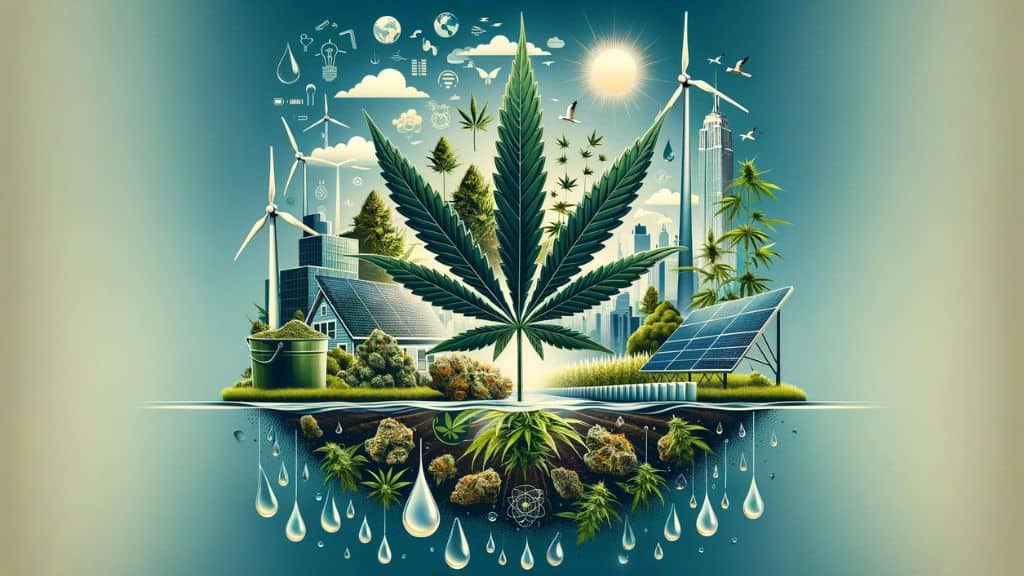The environmental impact of medical marijuana cultivation in New York is a multifaceted issue that intertwines water usage, energy consumption, land use, and the use of pesticides and chemicals. As the state emerges as a major player in the cannabis market, these environmental concerns become increasingly significant.
Cultivation practices, particularly indoors, demand substantial amounts of water and energy, primarily for lighting, heating, ventilation, and air conditioning, contributing to New York’s carbon footprint and potentially affecting indoor air quality through the emission of volatile organic compounds. The use of land for marijuana cultivation can lead to habitat disruption, while pesticides and chemicals pose risks to wildlife and water quality.
However, this growing industry also presents an opportunity for New York to adopt sustainable practices that mitigate environmental impacts. This exploration encourages readers to consider how medical marijuana cultivation affects their environment and the importance of supporting sustainable practices within the industry. By understanding these challenges, New Yorkers can advocate for and adopt practices that ensure the environmental sustainability of medical marijuana cultivation, making it crucial for patients, cultivators, and policymakers alike to be informed and engaged.
This blog delves into the nuanced environmental considerations surrounding medical marijuana cultivation, offering insights into how stakeholders can work together to address these pressing environmental challenges.
Table of Contents
Toggle- What is the current landscape of medical marijuana cultivation in New York?
- Why is understanding the environmental impact of medical marijuana cultivation important for New Yorkers?
- Environmental Impact of Medical Marijuana Cultivation in New York
- Water Usage
- Energy Consumption
- Land Use
- Pesticides and Chemicals
- Waste Management
- Climate Change
- Sustainable Practices
- Community Engagement for Environmental Sustainability
- Conclusion
What is the current landscape of medical marijuana cultivation in New York?
New York’s journey towards legalizing medical marijuana has been notable, especially since the Marijuana Regulation and Taxation Act (MRTA) was signed into law by Governor Andrew Cuomo in March 2021. This law marked a significant shift in the state’s approach to cannabis, legalizing adult possession and use. Despite this progress, New York continues to navigate the complexities of regulating, licensing, and taxing cannabis uniquely. The state’s Cannabis Control Board has approved a set of regulations that include licensing requirements for distributors, aiming to ensure a fair market.
However, challenges persist, including legal hurdles that could impact the industry’s future. The state’s efforts to bring equity to those most affected by the drug war have seen mixed results, with established businesses often prevailing in securing licenses. As New York progresses, the cannabis industry is poised for growth, underscored by developments like MSO partnership opportunities and upcoming Cannabis Grower Showcase events.
Why is understanding the environmental impact of medical marijuana cultivation important for New Yorkers?
Understanding the environmental impact of medical marijuana cultivation is crucial for New Yorkers for several reasons. The cultivation process requires significant resources, including water, energy, and land, which can contribute to environmental degradation if not managed sustainably. Additionally, the use of pesticides and chemicals in cultivation can harm local ecosystems, affecting wildlife and water quality.
As New York’s medical marijuana industry grows, it’s vital to adopt practices that minimize these environmental impacts. This not only ensures the sustainability of the industry but also protects the health and well-being of New York’s communities and natural habitats. By being informed and engaging in sustainable cultivation practices, New Yorkers can support an environmentally responsible medical marijuana industry that balances economic growth with ecological stewardship.
Environmental Impact of Medical Marijuana Cultivation in New York
Water Usage
New York’s regulatory framework for medical marijuana cultivation emphasizes environmental sustainability, with specific regulations aimed at conserving water and protecting local water resources. The state’s approach to managing water usage in cannabis cultivation is a testament to its commitment to environmental stewardship and sustainable agricultural practices.
Regulations and Implications
The New York State Department of Health requires a medical marijuana grower/processor license for commercial cultivation, ensuring that cultivators adhere to environmental regulations, including those related to water usage. These regulations are designed to prevent contamination and preserve surface and groundwater resources, highlighting the importance of responsible water management practices in the cultivation process.
Cultivators must comply with the state’s clean water laws, focusing on water pollution prevention to safeguard New York’s water quality. This includes establishing a viable water management plan, using integrated pest management techniques, and adhering to strict guidelines on pesticide use. The aim is to minimize environmental impact while promoting sustainable cultivation methods that conserve natural resources.
Environmental Sustainability and Conservation
New York’s cultivation regulations underscore the importance of environmental sustainability and conservation. By requiring growers to follow guidelines that conserve water, limit runoff, and use environmentally friendly pest management practices, the state ensures that the medical marijuana industry contributes positively to the preservation of natural resources. These efforts align with New York’s broader environmental goals and demonstrate the state’s leadership in promoting sustainable cannabis cultivation.
Energy Consumption
The energy demands of indoor medical marijuana cultivation facilities are significant due to the necessity for precise climate control and lighting to ensure quality crops. These requirements lead to substantial electricity use, primarily sourced from non-renewable energy, which impacts New York’s carbon footprint and places pressure on the electric grid.
Energy Demands and Consumption
Indoor cultivation facilities consume a considerable amount of electricity, up to an astounding 2,000 watts per minute, to maintain the necessary climate and lighting conditions for cannabis plants. This level of consumption accounts for at least 1% of the total electricity usage in the U.S., showcasing the extensive energy requirements of the cannabis industry.
Impact on New York’s Carbon Footprint
The reliance on electricity, often sourced from fossil fuels, for indoor cannabis cultivation significantly contributes to greenhouse gas emissions. These emissions are a concern for New York’s environmental goals, as the state aims to reduce its carbon footprint and transition towards more sustainable energy sources.
The greenhouse gas emissions from indoor cannabis production are primarily attributed to electricity generation and natural gas consumption, necessary for indoor environmental controls and high-intensity grow lights.
Regulatory Measures and Sustainability Efforts
In response to the high energy consumption of cannabis cultivation facilities, state and local lawmakers have begun to implement regulations aimed at improving energy efficiency and sustainability. These measures include requirements for energy planning and reporting, adherence to energy efficiency standards, and the encouragement of renewable energy use among growers. Such regulations are designed to mitigate the environmental impact of cannabis cultivation and promote more sustainable practices within the industry.
Land Use
Land Use Patterns and Medical Marijuana Cultivation
In New York, the legalization of recreational and medical marijuana has introduced new dynamics into land use patterns. With the state’s Marijuana Regulation and Taxation Act permitting individuals aged 21 and older to grow marijuana at home for personal use, there’s a notable shift towards accommodating cannabis cultivation within residential and potentially agricultural settings. This development is poised to alter land use, as areas previously designated for traditional agriculture or unused might be converted into cannabis cultivation sites.
Consequences of Converting Land for Medical Marijuana Farms
The conversion of agricultural or wild lands into medical marijuana farms carries several implications. On one hand, it offers economic opportunities and can contribute to the revitalization of rural areas. Cannabis cultivation, being labor-intensive, could lead to job creation and stimulate local economies. On the other hand, there are environmental concerns to consider.
The shift from traditional agriculture to cannabis cultivation might affect biodiversity, water usage, and local ecosystems. Moreover, the expansion of cannabis farms could lead to a reevaluation of land use regulations and zoning laws to address these new agricultural practices.
New York’s approach to cannabis cultivation also emphasizes social and economic equity, aiming to rectify past injustices associated with cannabis criminalization. This includes prioritizing licenses for individuals and communities disproportionately affected by previous laws, which could influence land use decisions in favor of these communities.
Pesticides and Chemicals
Types of Pesticides and Chemicals Used
In New York, the Department of Health’s Medical Marijuana Program strictly regulates the use of pesticides and chemicals in marijuana cultivation. Only certain fungicides, herbicides, insecticides, and fertilizers that are registered with the US Environmental Protection Agency are permitted.
These substances must not contain any prohibited ingredients or additives, ensuring that cultivation practices meet safety standards to protect both consumers and the environment. The goal is to minimize the adverse effects associated with pesticide use while maintaining effective pest control measures.
Impact on Local Wildlife and Water Quality
The use of pesticides in agriculture, including marijuana cultivation, can have significant implications for local wildlife and water quality. Pesticides can leach into soil and waterways, potentially contaminating groundwater and surface water. This contamination can harm aquatic life and other wildlife, disrupt ecosystems, and pose risks to human health through the water supply. Moreover, the chemicals used can affect non-target species, leading to a decrease in biodiversity.
In response to these challenges, some growers are adopting safe pesticide practices and biological pest control methods. For instance, utilizing beneficial insects like ladybugs and lacewings to control pests naturally can reduce the reliance on chemical pesticides. This approach is not only environmentally friendly but also aligns with consumer preferences for organically grown cannabis, free from synthetic additives and harmful chemicals.
Overall, while New York’s regulatory framework aims to ensure the safe use of pesticides in marijuana cultivation, ongoing efforts to promote sustainable and environmentally friendly practices are crucial. By prioritizing integrated pest management techniques and exploring organic cultivation methods, the industry can mitigate its environmental impact and contribute to the conservation of New York’s natural resources.
Waste Management
Managing Cannabis Waste
In New York, the handling and disposal of waste from medical marijuana cultivation are subject to specific regulations to ensure environmental safety and compliance with state laws. Cannabis waste includes any material that has come into contact with cannabis during the cultivation, production, manufacturing, or retail process that must be discarded.
This can range from unused buds and expired edibles to plant trimmings and empty cannabis packaging. The state mandates that cannabis waste be either hazardous or non-hazardous, with the classification and subsequent disposal methods determined by individual state regulations.
Environmental Risks of Improper Disposal
Improper disposal of cannabis waste poses significant environmental risks. When not managed correctly, cannabis waste can contaminate soil and waterways, adversely affecting wildlife and the broader ecosystem. Hazardous waste from cannabis cultivation, including chemicals used in the extraction process or residual tetrahydrocannabinol (THC), can harm local fauna and disrupt ecological balance if released into the environment.
To mitigate these risks, cannabis waste must be rendered unrecognizable and unusable, often requiring it to be mixed with non-hazardous waste materials until the cannabis content is sufficiently diluted. Additionally, states like Colorado have established protocols that include securing cannabis waste in locked containers and maintaining detailed logs of disposal activities, practices that could serve as a model for New York’s waste management policies.
Cannabis Waste Management Services
For businesses involved in cannabis cultivation, navigating the complexities of waste disposal while ensuring compliance with state and federal regulations can be challenging. Cannabis waste management services offer a solution, providing expertise in the compliant removal of both hazardous and non-hazardous cannabis waste. These services ensure that cannabis waste is disposed of in a manner that meets state regulatory requirements, safeguarding both public health and the environment.
Climate Change
Medical marijuana cultivation in New York has the potential to contribute to climate change mitigation, albeit through carefully managed practices that minimize the environmental impact of cultivation activities. The key to reducing the carbon footprint of medical marijuana farms lies in adopting sustainable cultivation practices, energy efficiency, and innovative technologies.
Climate Change Mitigation Potential
The cultivation of medical marijuana, like any agricultural practice, has the potential to impact climate change positively or negatively, depending on the methods used. Sustainable agricultural practices can help sequester carbon, enhance soil health, and reduce greenhouse gas emissions.
In New York, investments in reforestation, afforestation, and methane management from agricultural practices, including potentially those associated with marijuana cultivation, are identified as significant contributors to greenhouse gas mitigation. These practices not only help in reducing emissions but also stimulate local economies and support rural development.
Practices to Minimize Carbon Footprint
- Energy Efficiency in Indoor Cultivation: A significant portion of the cannabis industry relies on indoor cultivation, which is energy-intensive due to the need for artificial lighting, temperature control, and ventilation systems. Adopting energy-efficient technologies such as LED lighting and optimizing environmental control systems can significantly reduce energy consumption. It’s noted that the cannabis industry accounts for more than 1% of the U.S.’s total electricity consumption, with the potential for this figure to rise as the industry grows. Thus, improving energy efficiency in indoor cultivation is crucial for reducing the carbon footprint.
- Outdoor and Greenhouse Cultivation: Whenever possible, transitioning to outdoor or greenhouse cultivation can reduce energy consumption. Greenhouses, while still requiring energy for temperature control and supplemental lighting, are more energy-efficient than fully indoor operations. Outdoor cultivation has the lowest energy demand, although it’s subject to local climate conditions and regulatory environments.
- Waste Management: Proper disposal and management of cannabis waste are essential to prevent environmental contamination and reduce landfill use. Composting organic waste and recycling or repurposing cultivation by-products can minimize the environmental footprint of cannabis farms.
- Water Management: Efficient water use practices, such as drip irrigation and water recycling systems, can reduce water consumption and minimize runoff, which is particularly important given the water-intensive nature of cannabis cultivation.
- Sustainable Agricultural Practices: Implementing sustainable agricultural practices, including organic cultivation, integrated pest management, and soil conservation techniques, can further reduce the environmental impact of cannabis cultivation. These practices not only mitigate climate change but also enhance biodiversity and ecosystem health.
Farmers in regions like New York and Pennsylvania have expressed concerns about climate impacts on agriculture, including soil erosion, flooding, and shifting seasons, which affect farm viability. While skepticism towards human-caused climate change exists, there’s a recognition of increased vulnerability under changing climate conditions. Farmers are willing to adopt practices that make economic sense and can potentially mitigate climate impacts.
Sustainable Practices
Water Conservation Techniques
To address the environmental impact of cultivation, growers are shifting towards more sustainable practices. Techniques like rainwater harvesting and drip irrigation are being employed to minimize water usage. Additionally, recycling water through closed-loop irrigation systems ensures that water is used responsibly and efficiently.
Energy-Efficient Growing
The energy demands of indoor cannabis cultivation are significant due to lighting and climate control systems. Many growers are transitioning to LED lighting, which is far more energy-efficient than traditional grow lights. The adoption of solar-powered operations and the design of energy-efficient greenhouses are also on the rise, contributing to a reduction in the overall energy footprint.
Organic and Natural Farming Practices
Organic cultivation stands at the forefront of eco-friendly practices. By avoiding synthetic pesticides and fertilizers, organic growers not only maintain soil health but also promote biodiversity. Composting, natural pest control, and the introduction of beneficial insects into the cultivation process are crucial to these sustainable practices.
Reducing Carbon Footprint
Cannabis growers are becoming increasingly aware of their carbon footprint. Techniques such as carbon sequestration in soil, local sourcing of materials, and minimizing transportation requirements are being adopted to reduce environmental impacts and support the industry’s sustainability goals.
How Patients Can Support Environmentally Responsible Medical Marijuana Cultivation
Patients play a crucial role in promoting environmentally responsible cultivation practices. By choosing products from growers who use sustainable methods, patients can drive demand for eco-friendly cannabis. Supporting local dispensaries that prioritize sustainability and asking about the cultivation practices of their suppliers can also make a significant difference. Furthermore, educating oneself and others about the environmental impact of cannabis cultivation encourages a shift towards more sustainable practices across the industry.
New York’s Approach to Sustainability in Cannabis Cultivation
New York’s Cannabis Control Board (CCB) and Office of Cannabis Management (OCM) are taking steps to ensure equity, inclusion, and sustainability in the state’s cannabis market. The CCB is tasked with overseeing cultivation, production, distribution, sale, and taxation of cannabis and hemp, including developing rules for adult-use home growing and medical cannabis home growing. This regulatory framework includes considerations for sustainable practices and environmental stewardship within the industry.
Community Engagement for Environmental Sustainability
Engaging Communities with Medical Marijuana Cultivators
Communities in New York have the opportunity to engage with medical marijuana cultivators to champion environmental sustainability. This collaborative effort focuses on supporting initiatives that mandate participation in environmental sustainability programs for cultivators. With the Cannabis Control Board approving licenses for recreational marijuana cultivators, emphasis is placed on environmental stewardship and social equity. Communities can play a pivotal role by supporting these values and encouraging practices that mitigate environmental impacts.
Educational Resources on Environmental Impact and Cultivation Practices
New York has set forth regulations that underscore the importance of environmental sustainability in marijuana cultivation. These regulations, overseen by the Department of Environmental Conservation, cover crucial aspects such as water usage, air emissions, waste disposal, and pest control.
Adherence to clean water laws and the requirement for a pesticide applicator’s license are among the measures aimed at minimizing environmental impacts and conserving natural resources. For cultivators and patients interested in sustainable practices, the state provides educational resources and guidelines to ensure compliance with environmental regulations.
By leveraging these resources and actively participating in state and community programs, stakeholders can enhance their understanding and implementation of sustainable cultivation practices. This collaborative approach not only ensures compliance with environmental regulations but also fosters a cannabis industry that is environmentally responsible and beneficial to local communities and ecosystems.
Conclusion
The environmental impact of medical marijuana cultivation in New York is multifaceted, balancing between regulatory efforts to minimize ecological footprints and the inherent challenges of agricultural practices. State regulations, including those overseen by the Department of Environmental Conservation, emphasize water conservation, energy efficiency, pesticide control, and waste management to ensure sustainable cultivation practices.
Initiatives like the environmental sustainability program and social equity mentorship underscore a commitment to environmental stewardship and community engagement. However, cultivation’s impact on water resources, land use, and carbon emissions remains a concern that requires continuous monitoring and adaptation of practices. Through collaborative efforts between communities, cultivators, and regulatory bodies, New York aims to develop a medical marijuana industry that not only meets the demand for medical cannabis but also preserves environmental integrity.
Resources
https://farmandenergyinitiative.org/projects/cannabis-energy-law/
https://www.nature.com/articles/s41893-021-00691-w
https://marijuanaandthelaw.com/new-york-cannabis-cultivation-laws/
https://www.ppic.org/blog/regulating-marijuana-as-a-crop/
https://www.theregreview.org/2015/09/15/sell-ca-marijuana-environmental-regs/





